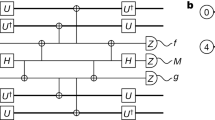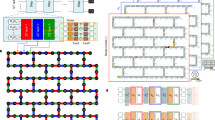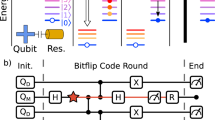Abstract
Quantum computation, a paradigm of computing that is completely different from classical methods, benefits from theoretically proved speed-ups for certain problems and can be used to study the properties of quantum systems1. Yet, because of the inherently fragile nature of the physical computing elements (qubits), achieving quantum advantages over classical computation requires extremely low error rates for qubit operations, as well as substantial physical qubits, to realize fault tolerance via quantum error correction2,3. However, recent theoretical work4,5 has shown that the accuracy of computation (based on expectation values of quantum observables) can be enhanced through an extrapolation of results from a collection of experiments of varying noise. Here we demonstrate this error mitigation protocol on a superconducting quantum processor, enhancing its computational capability, with no additional hardware modifications. We apply the protocol to mitigate errors in canonical single- and two-qubit experiments and then extend its application to the variational optimization6,7,8 of Hamiltonians for quantum chemistry and magnetism9. We effectively demonstrate that the suppression of incoherent errors helps to achieve an otherwise inaccessible level of accuracy in the variational solutions using our noisy processor. These results demonstrate that error mitigation techniques will enable substantial improvements in the capabilities of near-term quantum computing hardware.
This is a preview of subscription content, access via your institution
Access options
Access Nature and 54 other Nature Portfolio journals
Get Nature+, our best-value online-access subscription
$29.99 / 30 days
cancel any time
Subscribe to this journal
Receive 51 print issues and online access
$199.00 per year
only $3.90 per issue
Buy this article
- Purchase on Springer Link
- Instant access to full article PDF
Prices may be subject to local taxes which are calculated during checkout




Similar content being viewed by others
Data availability
The data that support the findings of this study are available from the corresponding author on reasonable request.
References
Feynman, R. P. Simulating physics with computers. Int. J. Theor. Phys. 21, 467–488 (1982).
Shor, P. W. Scheme for reducing decoherence in quantum computer memory. Phys. Rev. A 52, 2493–2496 (1995).
Steane, A. M. Error correcting codes in quantum theory. Phys. Rev. Lett. 77, 793–797 (1996).
Temme, K., Bravyi, S. & Gambetta, J. M. Error mitigation for short-depth quantum circuits. Phys. Rev. Lett. 119, 180509 (2017).
Li, Y. & Benjamin, S. C. Efficient variational quantum simulator incorporating active error minimization. Phys. Rev. X 7, 021050 (2017).
Yung, M.-H. et al. From transistor to trapped-ion computers for quantum chemistry. Sci. Rep. 4, 3589 (2014).
Peruzzo, A. et al. A variational eigenvalue solver on a photonic quantum processor. Nat. Commun. 5, 4213 (2014).
Farhi, E., Goldstone, J. & Gutmann, S. A quantum approximate optimization algorithm. Preprint at https://arxiv.org/abs/1411.4028 (2014).
Kandala, A. et al. Hardware-efficient variational quantum eigensolver for small molecules and quantum magnets. Nature 549, 242–246 (2017).
Preskill, J. Quantum computing in the NISQ era and beyond. Preprint at https://arxiv.org/abs/1801.00862 (2018).
McClean, J., Romero, J., Babbush, R. & Aspuru-Guzik, A. The theory of variational hybrid quantum-classical algorithms. New J. Phys. 18, 023023 (2016).
O’Malley, P. J. J. et al. Scalable quantum simulation of molecular energies. Phys. Rev. X 6, 031007 (2016).
Endo, S., Benjamin, S. C. & Li, Y. Practical quantum error mitigation for near-future applications. Phys. Rev. X 8, 031027 (2018).
Richardson, L. F. IX. The approximate arithmetical solution by finite differences of physical problems involving differential equations, with an application to the stresses in a masonry dam. Phil. Trans. R. Soc. Lond. A 210, 307–357 (1911).
Dumitrescu, E. et al. Cloud quantum computing of an atomic nucleus. Phys. Rev. Lett. 120, 210501 (2018).
Müller, C., Lisenfeld, J., Shnirman, A. & Poletto, S. Interacting two-level defects as sources of fluctuating high-frequency noise in superconducting circuits. Phys. Rev. B 92, 035442 (2015).
Koch, J. et al. Charge-insensitive qubit design derived from the Cooper pair box. Phys. Rev. A 76, 042319 (2007).
McKay, D. C., Wood, C. J., Sheldon, S., Chow, J. M. & Gambetta, J. M. Efficient Z gates for quantum computing. Phys. Rev. A 96, 022330 (2017).
Paraoanu, G. S. Microwave-induced coupling of superconducting qubits. Phys. Rev. B 74, 140504 (2006).
Sheldon, S., Magesan, E., Chow, J. M. & Gambetta, J. M. Procedure for systematically tuning up cross-talk in the cross-resonance gate. Phys. Rev. A 93, 060302 (2016).
Magesan, E., Gambetta, J. M. & Emerson, J. Characterizing quantum gates via randomized benchmarking. Phys. Rev. A 85, 042311 (2012).
Colless, J. I. et al. Computation of molecular spectra on a quantum processor with an error-resilient algorithm. Phys. Rev. X 8, 011021 (2018).
Hempel, C. et al. Quantum chemistry calculations on a trapped-ion quantum simulator. Phys. Rev. X 8, 031022 (2018).
Spall, J. C. Multivariate stochastic approximation using a simultaneous perturbation gradient approximation. IEEE Trans. Automat. Contr. 37, 332–341 (1992).
McClean, J. R., Kimchi-Schwartz, M. E., Carter, J. & de Jong, W. A. Hybrid quantum-classical hierarchy for mitigation of decoherence and determination of excited states. Phys. Rev. A 95, 042308 (2017).
Lanyon, B. P. et al. Towards quantum chemistry on a quantum computer. Nat. Chem. 2, 106–111 (2010).
Bravyi, S., Gambetta, J. M., Mezzacapo, A. & Temme, K. Tapering off qubits to simulate fermionic Hamiltonians. Preprint at https://arxiv.org/abs/1701.08213 (2017).
Egger, D. J. et al. Pulsed reset protocol for fixed-frequency superconducting qubits. Phys. Rev. X 8, 031022 (2018).
Wallman, J. J. & Emerson, J. Noise tailoring for scalable quantum computation via randomized compiling. Phys. Rev. A 94, 052325 (2016).
Havlicek, V. et al. Supervised learning with quantum enhanced feature spaces. Preprint at https://arxiv.org/abs/1804.11326 (2018).
Chow, J. M. et al. Implementing a strand of a scalable fault-tolerant quantum computing fabric. Nat. Commun. 5, 4015 (2014).
Córcoles, A. D. et al. Demonstration of a quantum error detection code using a square lattice of four superconducting qubits. Nat. Commun. 6, 6979 (2015).
Bergeal, N. et al. Analog information processing at the quantum limit with a josephson ring modulator. Nat. Phys. 6, 296–302 (2010).
Abdo, B., Schackert, F., Hatridge, M., Rigetti, C. & Devoret, M. Josephson amplifier for qubit readout. Appl. Phys. Lett. 99, 162506 (2011).
Motzoi, F., Gambetta, J. M., Rebentrost, P. & Wilhelm, F. K. Simple pulses for elimination of leakage in weakly nonlinear qubits. Phys. Rev. Lett. 103, 110501 (2009).
Chow, J. M. et al. Simple all-microwave entangling gate for fixed-frequency superconducting qubits. Phys. Rev. Lett. 107, 080502 (2011).
Córcoles, A. D. et al. Process verification of two-qubit quantum gates by randomized benchmarking. Phys. Rev. A 87, 030301 (2013).
Rigetti, C. & Devoret, M. Fully microwave-tunable universal gates in superconducting qubits with linear couplings and fixed transition frequencies. Phys. Rev. B 81, 134507 (2010).
Magesan, E. & Gambetta, J. M. Effective Hamiltonian models of the cross-resonance gate. Preprint at https://arxiv.org/abs/1804.04073 (2018).
Sheldon, S. et al. Characterizing errors on qubit operations via iterative randomized benchmarking. Phys. Rev. A 93, 012301 (2016).
Efron, B. in Breakthroughs in Statistics 569–593 (Springer, 1992).
Acknowledgements
We thank J. Rozen, M. Takita, and O. Jinka for experimental contributions, B. Abdo for design and characterization of the Josephson parametric converters, and M. Brink for device fabrication. We acknowledge discussions with S. Brayvi, E. Magesan, S. Sheldon, and M. Takita. We acknowledge support from the IBM Research Frontiers Institute. The research is based on work supported by the Office of the Director of National Intelligence (ODNI), Intelligence Advanced Research Projects Activity (IARPA), via the Army Research Office contract W911NF-10-1-0324.
Author information
Authors and Affiliations
Contributions
A.K., K.T. and J.M.G. developed the experimental protocol, planned the experiments and analysed the experimental data. A.K. performed the experiments. A.D.C. contributed to the experimental set-up. A.M. contributed to the data analysis. A.K., K.T., J.M.C., and J.M.G. wrote the manuscript, with contributions from all authors.
Corresponding author
Ethics declarations
Competing interests
The authors declare that elements of this work are included in a patent filed by the International Business Machines Corporation with the US Patent and Trademark office.
Additional information
Publisher’s note: Springer Nature remains neutral with regard to jurisdictional claims in published maps and institutional affiliations.
Extended data figures and tables
Extended Data Fig. 1 Gate characterization.
a, b, Single-qubit (1Q, a) and two-qubit (2Q, b) error per gate (EPG), for a range of stretch factors c, obtained by randomized benchmarking (RB). The error bars represent the standard deviation of the exponential fits to the RB decay, for each stretch factor. The considered 1Q gates in a are for qubits Q0 (red), Q1 (yellow), Q2 (green), Q3 (blue) and the 2Q gates in b are CR0-1 (red), CR1-2 (green), CR3-2 (yellow).
Extended Data Fig. 2 Coherence and relaxation time fluctuations in superconducting qubits.
a, Repeated measurements of T1 and echo T2 show fluctuations that are larger than the error bars to the fits. The error bars represent the standard deviation of the exponential fits to each instance of the T1 and echo T2 decay curves. b, c, Decay of excited-state projector \(\langle {\Pi }_{1}\rangle \) for a standard T1 sequence (b) and T2 echo sequence (c), for stretch factors c = 1, 2 obtained using 105 samples. In both cases, the average decay over the total sampling duration for the different stretch factors is the same only when their measurements are grouped together (run 1), in contrast to when sampled separately (run 2 and run 3).
Extended Data Fig. 3 Hamiltonian tomography of the CR drive.
Amplitude dependence of the interaction terms in the cross-resonance drive CR3−2. The error bars represent the standard deviation of the interaction strengths, estimated from fits to Hamiltonian tomography20 for each CR drive amplitude. The dominant interactions in the drive are ZX and IX, with discernible nonlinearities in the strong drive limit. (a.u., arbitrary units.).
Extended Data Fig. 4 Error mitigation with a nonlinear CR drive.
Time evolution of \(\left\langle IZ\right\rangle \) under a simplistic CR drive JZX = −0.0159JΩ + 1.0541 × 10−6JΩ3, and fixed amplitude damping and dephasing channels, for drive amplitudes calibrated to ZXπ/2 gate times Tgate values 2J−1 (a), 3J−1 (b) and 6J−1 (c) and with stretch factors c = 1 (blue) and c = 2 (green). The mitigated time evolution (red) goes out of bounds for fast gates (large drive amplitudes), owing to the nonlinearity in the amplitude dependence.
Rights and permissions
About this article
Cite this article
Kandala, A., Temme, K., Córcoles, A.D. et al. Error mitigation extends the computational reach of a noisy quantum processor. Nature 567, 491–495 (2019). https://doi.org/10.1038/s41586-019-1040-7
Received:
Accepted:
Published:
Issue Date:
DOI: https://doi.org/10.1038/s41586-019-1040-7
This article is cited by
-
Short-depth QAOA circuits and quantum annealing on higher-order ising models
npj Quantum Information (2024)
-
Quantum error mitigation via quantum-noise-effect circuit groups
Scientific Reports (2024)
-
Quantum many-body simulations on digital quantum computers: State-of-the-art and future challenges
Nature Communications (2024)
-
Cross-platform comparison of arbitrary quantum processes
npj Quantum Information (2024)
-
Covariant quantum kernels for data with group structure
Nature Physics (2024)
Comments
By submitting a comment you agree to abide by our Terms and Community Guidelines. If you find something abusive or that does not comply with our terms or guidelines please flag it as inappropriate.



